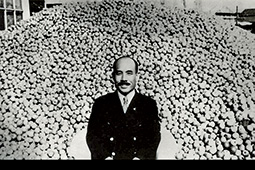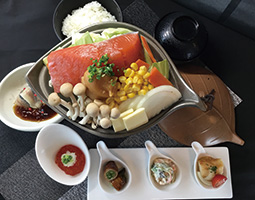INDEX

Whisky on the rocks (image photo) 
Nikka Whisky’s first whisky, “NIKKA WHISKY,” launched in 1940 
Nikka Whisky founder Taketsuru Masataka 
A lunch set showcasing Hokkaido produce including salmon
October 2020
Whisky Made the Old-fashioned Way—in Hokkaido

In Yoichi, a town nestled in the rich nature of Hokkaido, whisky that has earned high praise around the world for its flavor is made using traditional Scottish distilling techniques.

Yoichi, Japan’s leading premium single-malt whisky1, is made at Nikka Whisky Distilling Co., Ltd.’s Yoichi Distillery in Yoichi, a Hokkaido town often buried in deep snow facing the Sea of Japan. Its bold, complex flavor has received high praise at the World Whiskies Awards (WWA) and other spirits competitions around the world, where it has won many prizes.
Taketsuru Masataka, the Nikka Whisky founder known as the father of Japanese whisky, established the Yoichi Distillery.

“Taketsuru Masataka was born to a sake brewing family in Hiroshima Prefecture in 1894. He traveled alone to study abroad at the University of Glasgow in Scotland, spending about one year on an internship at several local distilleries,” explains Kiriyama Shuichi, a representative of Asahi Breweries, Ltd. responsible for the marketing of Nikka Whisky. “After returning to Japan, Taketsuru looked for an ideal place for making whisky. His search brought him to the town of Yoichi.”
Yoichi’s cool, humid climate is very much like Scotland, and it features an abundant water source and clear air. It is also a place where peat, which gives whisky its smoky aroma, is in plentiful supply**.

Whiskies become marketable after the distilled, unblended whiskies are aged for long periods. To support the business before the first whisky launched, Taketsuru established a company producing and selling apple juice in 1934. He began distilling whisky at the Yoichi Distillery two years after this***.
The Yoichi Distillery has kept its tradition of direct coal-fired distillation alive since its establishment. It’s a technique that is rarely used today, even in Scotland.

Kiriyama explains, “In direct coal-fired distillation, “moromi” (mash)**** is put in a pot still that is heated to more than 1,000°C. The mash is stirred continually to keep it from getting burned. The process requires skilled, experienced technicians who continue feeding the fire with coal to ensure that adequate heat is maintained throughout distillation. It may be an inefficient technique, but it gives Yoichi Single Malt its bold and complex character.”
Wooden casks enable the whisky to age over a long period.
Kiriyama says, “The whisky aging process, in which water is lost from the cask through transpiration, is faster in dry, hot conditions. Yoichi's climate is cold all year round so the whisky ages slowly.”

The whisky thus takes on many of the characteristics of the wood of the new casks that are mainly used for aging whisky at the Yoichi Distillery, which produces its rich, vanilla-like aroma. The casks absorb the winds blowing in from the Yoichi bay, and this sea breeze then blends into the whisky over its long aging period. For that reason, Yoichi Single Malt has a faint briny scent along with a smoky, peaty aroma which owes to the peat fires used to dry the malted barley. These characteristics enable Yoichi Single Malt to pair with seafood and smoked foods excellently.
There are nine historic buildings on the distillery premises, which the Japanese government has registered as Tangible Cultural Properties. The distillery offers guided tours, and there is also a restaurant where visitors can enjoy popular Hokkaido foods together with Yoichi Single Malt. Pairing this complex whisky and local foods amid the rich nature of Hokkaido where the products were nurtured is an experience not to be missed when there is an opportunity to visit.
* Not all wines made using grapes from Yamanashi Prefecture and produced in the prefecture are given this geographical indication. There are strict standards for grape variety, quality, production method, etc. A wine must meet all of these standards to use the geographical indication.
** Wines aged sur lie (French for "on the lees") are kept in contact with the lees (sediment) and are not racked (filtered) before bottling. The method is standard in red wine production, and is now used for numerous white grape varieties as well, to enrich the wine produced.

